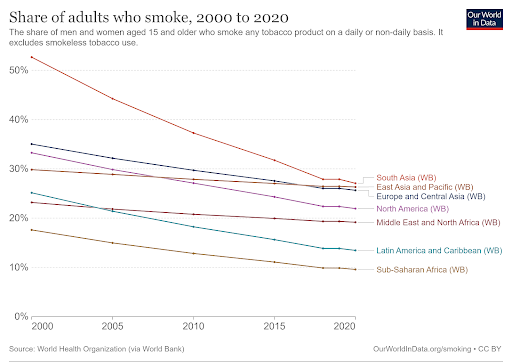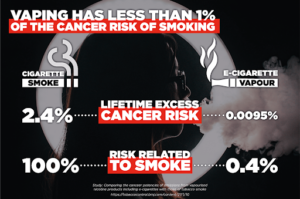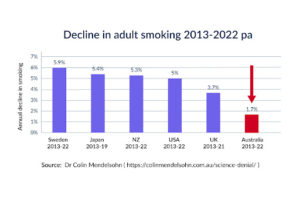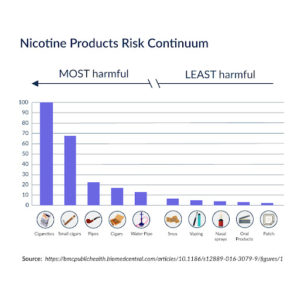Smoking is a global problem. There are approximately 1.3 billion tobacco users in the world. So far, the traditional approaches of quitting smoking have been shown to be greatly ineffective. Since the pioneering of nicotine-based smoking alternative products, we have seen huge progress in cutting smoking rates worldwide. For instance, Sweden, a country with a long tradition of promoting snus, but also nicotine pouches and vaping, is being celebrated for being the first country in the world to become smoke-free. The United Kingdom has slashed its smoking rates by almost 50% between the public endorsement of vaping by Public Health England in 2015 and 2021, now rolling out a nationwide program to encourage smokers to give up cigarettes by swapping it for a free vape instead. Harm reduction has been proven to be a driving force in the global fight against smoking.

This fact sheet aims to shed light on the issue of vaping and tobacco harm reduction, offering a comprehensive overview of the most relevant and up-to-date scientific research and regulatory policies around the world.
What is harm reduction?
Harm reduction aims to minimise the negative impacts of an activity. Just like seat belts and helmets enhance safety while driving, harm reduction seeks practical solutions over unrealistic ideals. It prioritises feasible ways to mitigate risks effectively.
Why is vaping harm reduction?
In terms of tobacco harm reduction, vaping stands out as a prime example. While complete abstinence may be what some consumers aspire toward, it’s often unattainable. Given the widespread demand for nicotine, as evidenced by the existence of millions of smokers, vaping offers a way to decouple nicotine consumption from the most harmful aspects of smoking. While not completely risk-free, vaping significantly reduces harm compared to smoking, making it a valuable alternative for smokers looking to mitigate their personal risk.
Is vaping less harmful than smoking?
Yes. There are well over 100 organizations & government institutions that agree vaping is less harmful than smoking.
Does vaping help smokers quit?
Yes. A new systematic evidence review including 78 completed studies from the British public health Non-Governmental Organization, Cochrane, confirmed that vaping helps smokers to quit. Cochrane’s systematic reviews are recognized globally as the gold standard in health evidence.
How should vaping be regulated?
What we need is a risk-based regulation. Vaping is 95% less harmful than smoking
and must not be treated in the same way. Less harmful alternatives should be less regulated than the most harmful product on the market — cigarettes.
Below are the most relevant studies compiled in the following areas:
Each chapter includes a references section at the end where all cited academic articles are compiled.
Research has demonstrated that although not completely harmless, vaping is much less harmful than smoking. The risk of cancer compared to smoking is virtually nonexistent. Here is the main evidence about the health effects of vaping in comparison with smoking:

There is enough evidence to conclude not only that vaping helps to quit smoking, but to say that vaping is one of the most efficient aids to do so. Vaping is a recommended means of quitting for smokers in France, the United Kingdom, Canada, and New Zealand; and it has been key in reducing smoking rates in countries that have an evidence-based approach towards it, such as in the United Kingdom, where smoking is at an all-time low. Here is the primary research:

Up to date, vaping is the most effective smoking cessation aid, as the highly regarded healthcare NGO Cochrane concluded in their latest meta-analysis carried out by Lindson et al. (2023).
Vaping as a gateway for adolescents into smoking is one of the most worrying myths in tobacco control. However, little to no evidence exists which lays out a connection between youth vaping and conventional smoking. There are many other reasons why youngsters smoke. Let’s take a look at what science has been able to show:
Other than the lack of evidence relating youth vaping with smoking, data shows that both youth smoking and vaping rates have been falling in many countries in recent years. The data from Action on Smoking and Health (ASH) UK shows that youth smoking rates are at an all-time low and data from the Office for National Statistics shows that youth vaping is rare among those who never smoked. Most users are current or former smokers. In the US, where we hear often about the so-called “vaping epidemic”, youth vaping dropped significantly in the past years.
Prof. Polosa et al. (2022)²⁵ summarised the pattern of youth use of vaping as: “EC use has surged greatly among high school students and young adults over the last decade but fortunately has declined significantly since its peak in 2019. During the same time period, smoking rates have constantly fallen to new low record levels. These trends argue against EC use as a gateway to smoking. Most EC usage is infrequent and unlikely to increase a person’s risk of negative health consequences. Furthermore, the majority of EC usage has happened among those who have previously smoked.” No gateway effect is in sight.
Flavours are one of the most contentious subjects as it regards public policy on vaping. It is commonly believed that flavours are targeted to teenagers and barely used by adults. However, a large body of research has established their importance for adults trying to quit, and there is ample evidence that flavour bans do more harm than good.
Here is the evidence around vaping flavours:
Friedman & Xu (2020),²⁶ researchers from the Yale School of Public Health, associated the use of vaping flavours with a 230% increase in the odds of adult smoking cessation and concluded that: “Adults who vaped flavoured e-cigarettes were more likely to subsequently quit smoking than those who used unflavored e-cigarettes. (…) Adults who began vaping non-tobacco-flavoured e-cigarettes were more likely to quit smoking than those who vaped tobacco flavours.”
Mendelsohn (2017),²⁷ on a submission to an Australian House of Representatives’ Committee, stated that flavours are more likely to keep people off traditional cigarettes, since they help them forget the flavour of tobacco: “Flavours are an important part of the appeal of vaping for adult smokers and make the products attractive as an alternative to smoking, just as flavours are also used to enhance the appeal of nicotine gum. Banning flavours would likely undermine the use of e-cigarettes and public health.”
Friedman (2020)²⁸ analyzed the effects of a flavour ban in San Francisco and found that it resulted in rising smoking rates among teenagers for the first time in decades.
Rich (2022)²⁹ analyzed the effects of a flavour ban in Massachusetts and concluded that it resulted in higher sales of cigarettes.
Gravely et al. (2020)³⁰ surveyed users of vaping non-tobacco flavours in Canada, the United Kingdom and the United States and found that, in the case of a flavour ban, 5 out of 10 would get their flavours from the back market or take up smoking again.
The Tholos Foundation (2022)³¹ analyzed the effects of a flavour ban in Estonia and found that 60% of vapers kept using them by mixing their own liquids or obtaining them from the black market.
Friedman et al. (2023)³² studied flavoured ENDS restrictions across the United States and estimated a tradeoff of 15 additional cigarettes for every 1 less 0.7 mL ENDS pod sold due to ENDS flavour restrictions. The authors concluded that “any public health benefits of reducing ENDS use via flavor restrictions may be offset by public health costs from increased cigarette sales.”
As the EU SCHEER (2021) report concluded: “To date, there is no specific data that specific flavourings used in the EU pose health risks for electronic cigarette users following repeated exposure.”
Taxes on Electronic nicotine-delivery systems (ENDS) are believed by many policymakers to be an instrument capable of reducing vaping use and improving public health. Regardless, most evidence shows that tax increases on e-cigarettes lead vapers to take up smoking again.
Taxes on alternative products should be set in accordance with their risk relative to that of cigarettes. From an incentives point of view, it does not make sense to tax traditional and electronic cigarettes the same way. Taxes on traditional cigarettes are meant to cover the healthcare costs and negative externalities derived from smoking. Since vaping is 95% less harmful for the user and does not have negative effects to those around him, it is only proportional that taxes are 95% lower too. This will not only be enough to cover the healthcare costs derived from vaping, but the price differential with traditional cigarettes will be yet another incentive for smokers to switch and improve public health and their own.
Nicotine is commonly believed to be harmful and the idea that vaping nicotine products cause cancer is equally widespread. It is, therefore, often claimed that vaping nicotine is as harmful as smoking. Despite the fact that e-cigarette vapour does not contain the most harmful elements in tobacco smoke, such as tar or carbon monoxide, it is believed it still causes cancer. However, nicotine has been proven relatively harmless:
George (2019)³⁹ studied the cardiovascular effects of switching from smoking to vaping and found that those who switch improve their health no matter if they keep consuming nicotine or not.
Foulds et al. (2021)⁴⁰ found that nicotine is an important factor in whether smokers are able to switch. The authors found that vaping “with nicotine delivery approaching that of a cigarette are more effective in helping ambivalent smokers to quit cigarette smoking.”
Niaura (2016)⁴¹ stated that “most of the physiological harm attributable to cigarette smoking derives from the toxicants in tobacco and combustion products. Preventable morbidity and mortality have overwhelmingly been related to combusted tobacco smoking, not to nicotine itself. Decoupled from combustion or other toxic modes of delivery, nicotine, by itself, is much less harmful.”
The view that nicotine is not the harmful component in tobacco products has been supported by several health organisations. The British National Health Service, following a pragmatic approach towards nicotine consumption and vaping, stated that: “While nicotine is the addictive substance in cigarettes, it’s relatively harmless. Almost all of the harm from smoking comes from the thousands of other chemicals in tobacco smoke, many of which are toxic.”
Similarly, Yorkshire Cancer Research stated: “Nicotine is not the cause of death from smoking. Nicotine is not a carcinogen; there is no evidence that sustained use of nicotine alone increases the risk of cancer. Of the three main causes of death from smoking (lung cancer, Chronic Obstructive Pulmonary Disease and cardiovascular disease), none are caused by nicotine. The harm from smoking comes from the thousands of other chemicals in tobacco smoke.”
Shirley Cramer, Chief Executive of Royal Society For Public Health, said: “Getting people onto nicotine rather than using tobacco would make a big difference to the public’s health – clearly there are issues in terms of having smokers addicted to nicotine, but this would move us on from having a serious and costly public health issue from smoking related disease to instead address the issue of addiction to a substance which in and of itself is not too dissimilar to caffeine addiction.”
Snus:
Snus is a smokeless, moist powder tobacco pouch which originated in Sweden, and is used by placing it under the top lip. The use of snus has surpassed the smoking of combustible cigarettes in Sweden. Sweden is on the way to becoming the first country to reach the smoke-free goal, with a current smoking rate of 5.6%. Even though the total nicotine consumption in Sweden is within a similar range to other European countries, smoking-related mortality is much lower, as demonstrated by Clarke et al. (2019).⁴²
Key facts:
Nicotine Pouches:
Nicotine pouches are the newest smoking alternative and, therefore, not yet adequately regulated in many countries. Nicotine pouches are used similarly to snus, but unlike snus they contain a nicotine powder instead of a tobacco leaf. Currently, they are either unregulated, entirely banned or treated the same as cigarettes in most countries — and none of these alternatives are optimal. With consumer-friendly regulation, nicotine pouches could be a cornerstone of our march toward smoke-free populations.
Key facts:
Alternative nicotine products have the potential to reduce smoking rates and improve public health. Proof of it is that countries with a relatively high adoption of alternative nicotine products such as vaping, heated tobacco, nicotine pouches, and snus, generally lower smoking rates faster than countries who refrain. The United Kingdom and Sweden prove that lower smoking rates can be achieved with an open approach toward alternative nicotine products.
The United Kingdom: helping smokers switch
The United Kingdom is the most progressive country in the world when it comes to vaping. The government and public health institutions fully endorse vaping as a harm reduction tool, and smokers are encouraged to switch to this less harmful alternative. In the UK, smoking rates had fallen by more than 29% in the last decade (when vaping became popular). Compared to the EU, smoking rates in the UK have fallen twice as fast, according to Fagerström (2022).⁴⁶ This year, the UK has launched ‘Swap-to-Stop’, the largest government supported stop smoking strategy to date using e-cigarettes.
Sweden: becoming the first smoke-free country with the help of snus
In Sweden, the use of snus has surpassed the smoking of combustible cigarettes mainly due to smokers switching to it. Thanks to the replacement of tobacco by this safer alternative, Sweden is on the way to becoming the first country to reach the smoke-free goal, with a smoking rate of 5.6% as of 2023. Even though total nicotine consumption in Sweden is within a similar range to their European neighbours, smoking-related mortality is much lower, as shown by Clarke et al. (2019),⁴⁷ proving snus a much less harmful product which can improve public health overall. Sweden is now looking to accelerate this process by reducing its tax on snus by 20%.
Japan: heat-not-burn products driving smoking rates down
Heat-not-burn (HnB) products heat the tobacco and create an inhalable aerosol instead of burning it like traditional cigarettes. Simonavicius et al. (2019) found that the lack of combustion makes them considerably safer than traditional cigarettes.⁴⁸ Due to their introduction and popularisation in Japan, within only five years (2016-2021), cigarette sales in cigarettes plummeted by 43%. More and more people in Japan are rejecting cigarettes and choosing less harmful alternative products such as heat-not-burn. The HnB rate in Japan is currently at about 4.5%, and the Health and Nutrition Survey found that 76% of HnB users were not smoking cigarettes at all anymore.
New Zealand: making smokers aware of safer alternatives
Providing smokers with accurate information on alternative products can help them make better decisions and improve their health. The Ministry of Health of New Zealand is the best-case example of communicating about vaping. The website VapingFacts, also supported by most public health organisations in New Zealand, provides accurate health information, cessation tips, a helpline, and in-person support opportunities. While other countries spread misinformation and ignore the extensive research supporting vaping as a smoking cessation method, New Zealand is driving smoking rates fastly by providing good information to smokers.
Based on both scientific evidence and successful government-backed policies such as those in Sweden and the United Kingdom, World Vapers’ Alliance suggests the following approaches be implemented on the institutional level:
A clear commitment to the concept of harm reduction: The goal of harm reduction is to reduce adverse consequences among persons who continue to use unhealthy products. It was developed in response to the unsuccessful “zero tolerance approach”. Instead of idealised goals, harm reduction puts practical solutions centre stage. Harm reduction has proved to be effective and is accepted in many countries.
Encourage current smokers to switch to vaping and similar less harmful products: Like the governments of France, the United Kingdom, Canada, and New Zealand, assist smokers in their effort to quit by promoting vaping as less harmful alternatives to cigarettes.
Guarantee access to vaping products for adults and prevent flavour bans: It is essential that affordability and variety are ensured. Flavour bans would hurt public health by pushing millions of vapers back to smoking or to the black market.
Risk-based regulation and taxation: A modern, open, risk-based regulatory framework focused on tobacco harm reduction should be implemented. Vaping is not smoking and must not be treated the same. Since vaping is less harmful than smoking, it should be less strictly regulated and taxed less than cigarettes. The same applies for other less harmful alternatives such as nicotine pouches, snus and heat-not-burn products.

Vaping has the potential to ensure 200 million smokers quit forever, but governments must encourage and facilitate it as a cessation method Now more than ever, it is vital that vapers’ voices are heard. to low-risk nicotine products such as vaping.
That’s why we’re taking our campaign out on the road, across Europe and around the world. We need to ensure that those making the key decisions that will affect OUR rights, OUR health and OUR futures, hear OUR collective voice and ‘Back Vaping. Beat Smoking.’
© 2024 – World Vapers’ Alliance. All rights reserved.